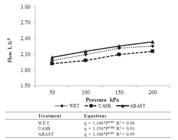ABSTRACT
The use of wastewater in agriculture is an alternative to control surface water pollution, and helps to promote the rational use of water. Therefore, the objective of this study was to evaluate the obstruction and uniformity of application of treated wastewater in drip irrigation systems. The study was conducted in a greenhouse at the Universidade Federal de Campina Grande. The treatments were composed by the factorial combination of two factors: three types of water (supply water-ABAST, effluent of a constructed wetland system -WETLAND and upflow of anaerobic reactor effluent followed by constructed wetland system -UASB + WETLAND), and two drip irrigation systems (surface and subsurface), set in a completely randomized design, with four replications. The results indicated that the pH, suspended solids, total iron and coliforms of the WETLAND and UASB + WETLAND treatments represented a severe risk of clogging of drippers; the flow of the emitters increased as the service pressure was increased; values of CUC and CUD in surface and subsurface drip were classified as excellent in ABAST and WETLAND treatments. The degree of clogging reduced as pressure under surface and subsurface drip was increased.
Key words:
performance; emitters; water quality; reuse

 Thumbnail
Thumbnail
 Thumbnail
Thumbnail
 Thumbnail
Thumbnail
 Thumbnail
Thumbnail



